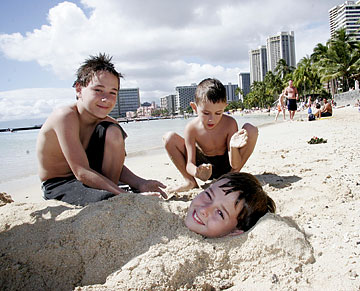
CRAIG T. KOJIMA / CKOJIMA@STARBULLETIN.COM
Kuhio Beach is due for sand replenishing next month. Enjoying the beach yesterday were Todd Morris, being buried by brothers, Beau, left, and Tommy.
|
|
Waikiki Sandman Cometh
A long-awaited project to refill Waikiki's sand bank is set to start
Waikiki's Kuhio Beach is expected to get an infusion of sand next month, fulfilling a replenishment plan that's been put off several times in the last few years.
Now that the permits are in place, the heavy equipment is on the island and it's just a matter of contractor American Marine staging the project to begin the first week of April, said Dolan Eversole, the University of Hawaii Sea Grant coastal geologist managing the project.
By the end of April, the stretch of beach between the Kapahulu Groin and the Duke Kahanamoku statue should have gained about 10,000 cubic yards of sand -- about 1,000 dump truck loads-worth -- all of it vacuumed from underwater deposits just 2,000 feet away, Eversole said.
The project was originally planned for fall 2004, then pushed back to last spring, and now to next month. Officials said the project has been delayed as they tried to get the proper permits and equipment lined up. They also wanted to schedule it in spring or fall to avoid peak tourism season and high surf in the summer.
Between 1939 and 2000, almost 250,000 cubic yards of sand were added to Kuhio Beach to widen it, according to the Department of Land and Natural Resources, which is responsible for the current $425,000 project.
That sand washed into Mamala Bay and now will be "recycled" by an underwater pumping system and reapplied to the beach, Eversole said. The beach hasn't had a significant replenishment since 1975.
Veteran surfer George Downing still has his doubts about how much beach goers want more beach sand, he said yesterday. But he said he is pleased that the state listened to his and others' requests that the project not put more sand in front of the Waikiki Police Substation, where they feared it could affect nearby Canoes and Baby Queens surf breaks.
Downing said he is now concerned that the work could be starting too close to the beginning of the summer swell season. "Sometimes there's a Mother's Day swell in early May," he said.
But Eversole said the project has to go now, or lose its funding. "We are definitely moving forward with this," he said.
If swells get higher than 4 feet Hawaiian-style (about 8-foot faces), the 82-foot barge that will support the operation will have to move offshore until the water is calmer, Eversole said.
Here's how he described the operation: The barge will stay anchored about 2,000 feet offshore, with a crane atop it. The crane will hold and manipulate a foot-and-a-half-wide head that will slurp up sand slurry off the bottom and propel it through an 8-inch-diameter pipe.
The pipe will be anchored underwater for most of its trip, so surfers and others can continue to use the water. It will empty at a holding area on the beach, where it will air dry.
The sand will be applied to beach at night, when there are fewer people using it, Eversole said.
"It should not affect any recreational uses in the water or on the beach for the most part, with the exception of the immediate staging area," he said.
Rick Egged, president of the Waikiki Improvement Association, said his group supports the project.
"I think the way the DLNR has planned the project, they will minimize the disruption to beach goers," he said.
Murray Towill, president of the Hawaii Hotel Association, added, "I think everybody is certainly in favor of enhancing that beach.
"At high tide, in some places, the water laps up against the wall."

